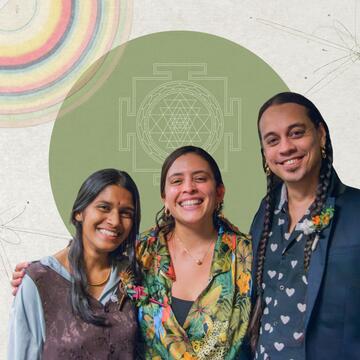An interview with Drama Therapy alumna Grace Walcott about her documentary, “River of Life LGBTQ+”

Finding Stability Amidst Change
Finding your center when the going gets rough
Finding stability amidst change, peace in times of chaos, your center when the going gets rough. That has been the focus of sages through the ages, and the recommended wisdom has usually gone something like this: breathe, detach, transcend, awaken, then reengage but with equanimity, because stress, pain, change and loss in this world of duality are ever present, but suffering is optional.
We should not conceive of stress as simply bad or good, but as a necessary component to the way mammals evolved and function in demanding environments. We need the right amount of stress in order to switch on our full capacities for development. But when our stress hormones run at full throttle for too long, the damaging cost—an excessive allostatic load—is destructive to various systems including the brain (hippocampus), the GI tract, and the coronary vessels.
De-Stressors that Work Wonders
Coping with unrelenting change, lowering the impact of stress, and building resilience are managed by activities that fall into several categories:
- Healthy lifestyle (diet, nutrition, exercise)
- Supportive relationships (effective communication, cognitive restructuring, social support, conflict resolution, Nonviolent communication, respectful listening, cultural competency)
- Mind-body techniques (guided imagery, breath work, yoga therapy, somatic self-soothing)
- Self-care (safety measures, medical check-ups, immunizations, wearing seat belts, bike helmets)
- Self-awareness (growing in the capacity to monitor your responses and stop unwanted habits or hyper-reactive emotional states from taking charge of your mental state and mood)
It can be overwhelming to try to introduce all these self-care practices at once, even though they are each a vital part of stress management, so I like to introduce people to these top four for starters.
Acceptance
It may seem counter-intuitive suggesting acceptance at a time when the world needs urgent attention. But there will be times when acceptance is called for in order to shore up resilience and address what’s needed (1). Resentment and a lack of forgiveness are destructive forces on human physiology. Studies have correlated ongoing negative emotions with chronic disease conditions, for example, chronic fatigue, fibromyalgia, Crohn’s disease, colitis, heart disease, cancer of the prostate and breast, multiple sclerosis and many more. It’s far better to accept conditions that you cannot change, and work toward a healthier, more positive outlook in the areas you can alter. The old adage, “Lord, give me the strength to change what I can, accept what I cannot, and the wisdom to know the difference,” may be the greatest health advice ever written.
Breath Work
We tend to hold the breath or breathe shallowly from the upper chest when worried or tense. Deep breathing from your diaphragm involves slow, focused inhalation through the nose, followed by a slow and complete exhalation, through the nose or mouth; inhalation and exhalation each for a count of four. Breathing from the “belly” activates the vagus nerve through the motion of the diaphragm, which stimulates the parasympathetic branch of the autonomic nervous system—the equivalent of putting the brakes on a revved-up system (2). Stillness starts with conscious deep breathing—all types of meditation, self-soothing actions, and somatic sensory awareness requires at least some time with deep belly breathing. Conscious breath work is the single most common ingredient involved in all the mind-body techniques to quiet the mind and shift energy to a calmer, relaxed state of well-being.
Contemplative Time or Meditation
New findings from neuroscience research tells us that the anterior cingulate (area of the brain that communicates between the primitive amygdala and the prefrontal cortex) is actually a center of empathy, social awareness, compassion and intuition. Spiritual practices such as prayer, yoga, or meditation can strengthen the anterior cingulate, while also soothing the frenzied activity of the amygdala (3). Uncontrolled anger can shut off the neural communication to the prefrontal cortex, making it harder to listen to the other or experience compassion. Meditation has the opposite effect; it increases blood flow to the frontal lobes and anterior cingulate, opening up more of a pipeline, essentially engaging more neural circuits. The end result is that you can feel more peaceful, more connected with something greater or expansive, and touch upon a unity experience.
Eudaemonia
If your happiness in life is primarily dependent upon a hedonic orientation, in which you primarily want to avoid pain and seek personal pleasure, then you may find that the happiness is not only fleeting but stresses out your genes. Aristotle proposed this “good spirit” would result in an uplifted life, and researchers found that hedonic attitudes are associated with a genetic expression of high levels of pro-inflammatory compounds (4). These stress biomarkers are linked to the development of autoimmune and gastrointestinal disorders, cardiovascular disease, cancer and diabetes. Yes, the source of your happiness matters. Consider cultivating eudaemonic values, which include having a higher life purpose and a desire to be in service to others. Increasing the ratio of time with the eudaemonic muse, versus the hedonic one, will lower the gene expression for pro-inflammatory compounds, while stimulating a corresponding boost in antibody-producing gene expression. In other words, eudaemonic values may result in less stress and enhanced immunity. The path to generating a more eudaemonic orientation to happiness is the path of self-realization, compassion, wisdom, and expanded meaning of life.
Adapted from Professor Meg Jordan’s How to Be a Health Coach: An Integrative Wellness Approach, Second Edition (2021).
References:
- Wersebe, H., Lieb, R., Meyer, A. H., Hofer, P., & Gloster, A. T. (2018). The link between stress, well-being, and psychological flexibility during an Acceptance and Commitment Therapy self-help intervention. International journal of clinical and health psychology : IJCHP, 18(1), 60–68. https://doi.org/10.1016/j.ijchp.2017.09.002
- Gerritsen, R., & Band, G. (2018). Breath of Life: The Respiratory Vagal Stimulation Model of Contemplative Activity. Frontiers in human neuroscience, 12, 397. https://doi.org/10.3389/fnhum.2018.00397
- Tang, Y. Y., Lu, Q., Geng, X., Stein, E. A., Yang, Y., & Posner, M. I. (2010). Short-term meditation induces white matter changes in the anterior cingulate. Proceedings of the National Academy of Sciences of the United States of America, 107(35), 15649–15652. https://doi.org/10.1073/pnas.1011043107
- Fredrickson, B. L., Grewen, K. M., Coffey, K. A., Algoe, S. B., Firestine, A. M., Arevalo, J. M., Ma, J., & Cole, S. W. (2013). A functional genomic perspective on human well-being. Proceedings of the National Academy of Sciences of the United States of America, 110(33), 13684–13689. https://doi.org/10.1073/pnas.1305419110
Related Academic Program
Related News
CIIS Professor Jason Butler discusses his new book on the potential, pitfalls, and guidelines for psychedelic medicine and care in treating mental illness.
Alumna Kevonya Elzia tells CIIS about her journey from the Integrative Health Studies and Transformative Leadership programs to being a community health nurse and health, equity and justice facilitator.



